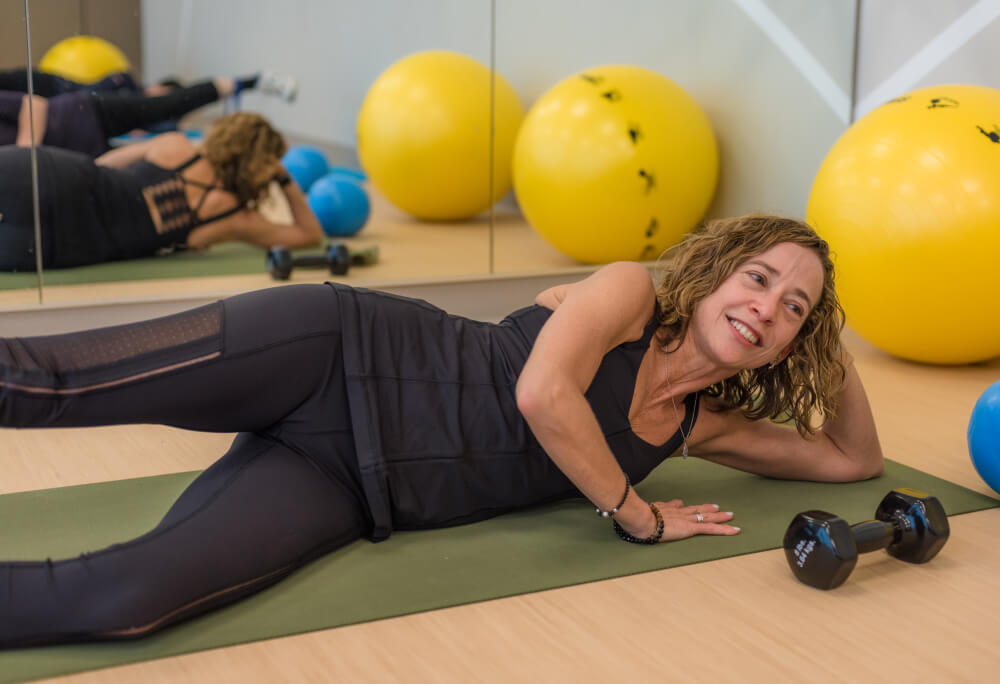- It’s important to stay as active as possible throughout treatment: not exercising can result in muscle loss and fat gain.
- The American Cancer Society recommends all patients, whether they are in active treatment or not, follow the U.S. Surgeon General’s physical activity guidelines.
- It’s important to eat plenty of protein and maintain good nutrition overall.
- Make sure to talk with your doctor before you start an exercise program.
Medically reviewed by Jennifer A. Ligibel, MD
Cancer can present a host of physical challenges. During treatment, a patient may not be able to move far from their bed or room; therapy can also lead to metabolic changes that disrupt the way the body processes food to create energy.
Add that to a hectic appointment schedule and the emotional toll a diagnosis can have, and working out may become the last priority for a patient. However, it’s important to stay as active as possible throughout treatment: not exercising can result in muscle loss and fat gain.
“It’s been proven that ‘just resting’ during chemotherapy isn’t actually the best thing to do,” explains Jennifer Ligibel, MD, director of the Leonard P. Zakim Center for Integrative Therapies and Healthy Living at Dana-Farber Cancer Institute. “Instead, it’s incredibly important for patients to stay active throughout treatment.”
Studies show that patients who have more muscle mass are often better able to care for themselves and continue working or engaging in other activities during treatment. In addition, they also tend to recover more quickly from cancer treatment. This is particularly true for older patients who tend to lose more muscle during cancer treatment than younger patients.
Here are a few tips Ligibel suggest all patients follow in order to help maintain muscle health during their cancer treatment.
Stay active
The American Cancer Society recommends all patients, whether they are in active treatment or not, follow the U.S. Surgeon General’s physical activity guidelines. These state that adults should get at least 150 minutes of moderate aerobic exercise (cardio) each week. Adults should also participate in strength training twice a week for all major muscle groups, with sessions lasting a minimum of 20 minutes.
Ligibel notes there isn’t one “right” cardio exercise patients should be doing; instead, it’s important to pick something you’re likely to stick with. Going for a walk is a good place to start, but don’t be afraid to try different activities. You may find you’re more apt to stick with your program if you exchange walking for swimming, or even taking a dance class.

In terms of strength training, be mindful of what your body can handle. There are many exercises you can do that incorporate the use of your own body weight rather than weights or machines. Pushups, abdominal crunches, lunges, and step-ups are all activities you can do at home to improve muscle health. It’s also important to talk to your surgeon about any restrictions related to your cancer surgery.
If you’re looking to participate in strength training at a higher level, Ligibel suggests working with a professional. The American College of Sports Medicine has a list of certified cancer exercise trainers who can develop workouts for you based on your particular diagnosis, treatment, and recovery status.
Before starting any exercise program, it’s important to talk with your doctor. For patients who were not active prior to their diagnosis, this conversation will include suggestions on how to work your way up. It may make sense to receive an exercise consultation; Dana-Farber’s Zakim Center offers individual consultations with an exercise specialist for Dana-Farber patients and survivors looking to start an exercise program or modify an existing routine. They also have options for daily exercise classes for patients at all fitness levels.
Equally, patients who were active prior to diagnosis may experience limitations during therapy and be required to initially scale back their workouts until they’re further along in treatment. In this instance, Ligibel suggests practicing patience: you will eventually get back to where you were, she says.
Get plenty of protein
Eating sources of protein is especially important for older patients who process protein less efficiently. A good rule of thumb is to eat one gram of protein for every kilogram of body weight. Protein is the building block for muscles and getting enough will help maintain muscle mass and promote muscle growth, if you’re sticking to your weekly strength training workouts.
Healthy proteins include:
- Fish
- Poultry
- Beans
- Nuts
If you’re still having trouble reaching the recommended amount, it may be helpful to try smoothies or protein shakes.
Maintain good nutrition
Getting an adequate amount of protein is just one aspect of maintaining good nutrition during and after treatment. Patients should strive for a well-balanced, plant-based diet consisting primarily of minimally processed and natural foods. When planning your meal, a good system to follow is organizing your plate into the following sections:
- 1/2 vegetables and/or whole fruits
- 1/4 protein
- 1/4 whole grains (or starchy vegetables)
- A moderate amount of healthy fats distributed through the meal
It’s also important to drink plenty of fluids, especially water. Not getting enough leads to dehydration, which can make you feel tired and harm your body’s ability to eliminate toxins.
Check out the Harvard Healthy Eating Plate for more tips on how to better plan healthy meals.
Maintaining good nutrition following a cancer diagnosis can be difficult, and Ligibel encourages patients to consult a nutritionist or registered dietician. They can help you create the optimal diet, as well as cope with any side effects that you may be experiencing.
